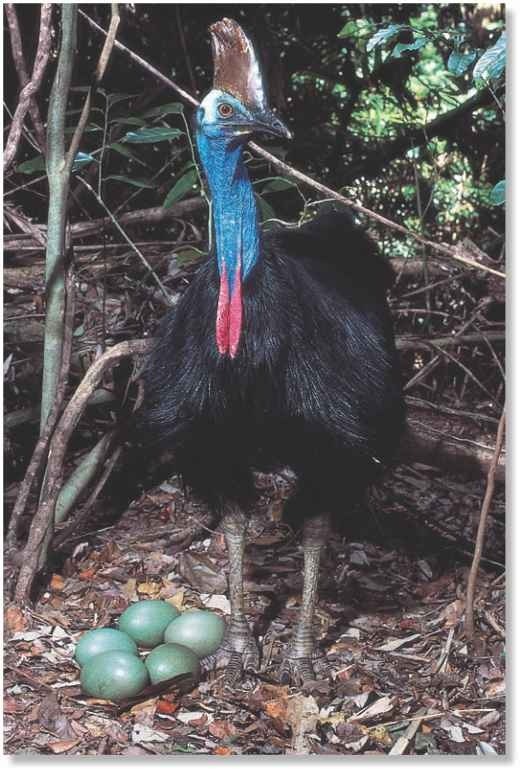ORDER
Casuariiformes
FAMILY
Casuariidae
GENUS & SPECIES
KEY FEATURES
• Though flightless land heavy, it can [sprint at 30 mph and tjump into the air to
its own head-height
• Female mates several times a year, leaving each partner to tend her eggs and young
• Lashes with daggerlike claws of its huge feet when in danger
• Has bizarre tassels of bare skin and a hard “helmet” on its head
WHERE IN THE WORLD?
Once more widespread, it now ranges over two areas in northeastern Queensland, Australia and lowland New Guinea; also on the island of Seram and Aru Islands, off New Guinea’s western coast
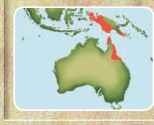
Lifecycle
One of the most ancient bird species alive, the double-wattled cassowary is notoriously bad tempered and dangerous if provoked, but prefers to lead a quiet life in thick forests.
HABITAT
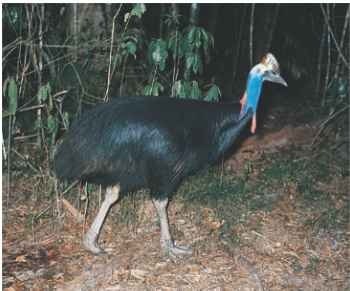
A Out of the limelight
The double-wattled cassowary keeps to thick cover in dark rainforests.
The double-wattled cassowary inhabits rainforests in areas that still remain relatively free from human disturbance. In New Guinea, it occurs at altitudes of up to 1,650′, occupying a central niche between the habitats of the two other species of cassowary, which inhabit lowland swamp forest and montane forest. It’s the only cassowary species in Australia, where it lives in rainforest at any altitude as there is no competition.
Left undisturbed, the cassowary stays in the same patch of rainforest for years, but forest destruction increasingly forces it to wander in search of new homes. Such movements may account for occasional sightings as it passes through commercial plantations.
• Local tribes make daggers from cassowary leg-bones and arrowheads from its claws.
To some New Guinean people, every cassowary is a female ancestor reincarnated.
BEHAVIOR
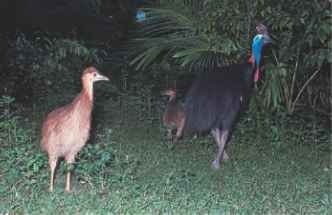
A Short temper When escorting young, a male can be aggressive.
FOOD & FEEDING
Access to a year-round supply of fruit is vital to the cassowary, which consumes about 7 lbs. a day in captivity. Most of the fruits it feeds on grow in the middle or upper canopy of the rainforest, so it waits until they ripen and drop to the ground. Then, it tosses them up with a flick of its bill, catches and swallows them whole. It also plucks fruits off low bushes. Favorite fruits are those of myrtle, laurel and palm trees, but at least 75 different fruit species have been identified in its diet in Queensland.
The cassowary’s large size means that it burns large amounts of energy and often supplements its sugar-rich diet of fruit with fungi, invertebrates (mainly insects and snails), small mammals and birds, even carrion. It catches and kills prey with its huge feet. When food is scarce, it sometimes strays into plantations for bananas and mulberries.
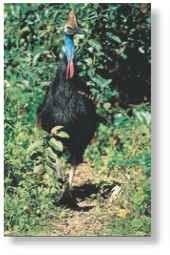
A Making tracks The cassowary creates “paths” between prime feeding sites by wearing down vegetation.
Outside the breeding season, the cassowary lives a largely silent and solitary life. Rarely seen since it’s shy and prefers the densest areas of forest, it’s most active on moonlit nights, in the early morning and during late afternoon. It rests in the middle of the day, often seeking out sunny spots in clearings.
If it’s threatened or cornered, the cassowary may attack its aggressor, but prefers to run into thick cover. When attacking, it ruffles up its plumage to appear larger, points its bill to the ground and rushes forward at a sprint, lashing out with its sharp claws.
A TYPICAL DAY
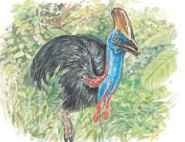
1 Crash helmet…
A cassowary pushes through thick undergrowth. Its head is protected from injury by its hornlike casque.
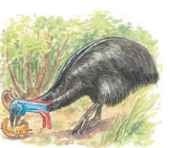
2 Fallen fruit…
Finding a durian fruit too large to swallow whole, the cassowary breaks it up with its hefty bill.
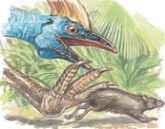
3 Killer kick…
Further in the forest, the bird disturbs a rat and gives chase until it can deliver a lethal kick.
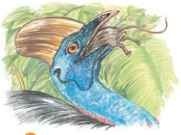
4 Down in one.
The cassowary tosses its dead prey into the air, catches it in its bill and gulps it down whole.
CONSERVATION
The forest-dwelling tribes of New Guinea have hunted the cassowary for its meat, feathers, bones and claws for many years, but the felling of its rainforest home is a far more serious threat to its long-term future. In Australia, cassowaries are killed on the roads as they wander in search of new habitats, while dogs and pigs eat their eggs and young.
BREEDING
The cassowary breeds when forest fruits are most plentiful — during the June to October dry season. Like its close relatives, the kiwis of New Zealand and the emu of Australia, the job of rearing the young is left to the male, which occupies a large, clearly defined territory of 0.4-2 sq. miles. The female seeks out a male and approaches his territory. On the defensive, he’s hesitant at first, but then raises the feathers on his back and moves up to her circling, puffing out his throat and making a rumbling, boo-boo-boo call.
After mating, the male makes a nest. A shallow hollow lined with vegetation, it’s so well camouflaged that few have ever been found. The female lays 3-5 eggs, which hatch after an incubation of 50 days. She then leaves to mate, and
lay more eggs, with other males. Chicks can walk and feed themselves in hours, but stay close to their parent for safety.
Man’s work
The male guards the young, which are striped at first, for 36 weeks.

Profile
double-wattled Cassowary
Massive legs let the double-wattled cassowary rush across the forest floor and kill prey as well as act as formidable defensive weapons.
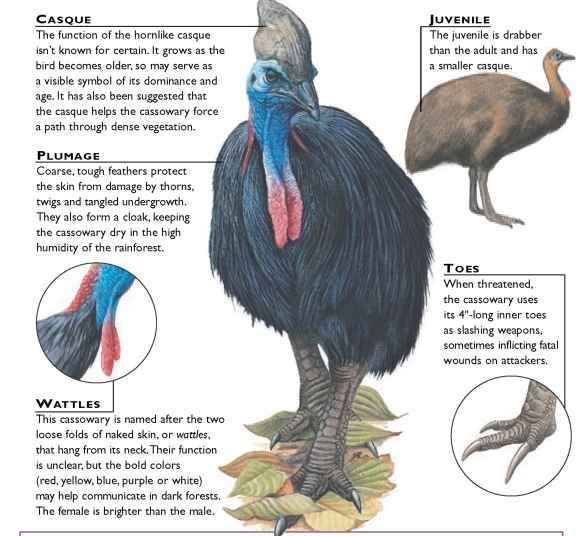
CREATURE COMPARISONS
The dwarf cassowary (Casuarius bennetti), despite being smaller than the double-wattled, is even more aggressive when cornered and is considered to be the world’s most dangerous bird. It raises its body and kicks with its legs or charges its aggressor while flailing its legs and slashing with its claws. One blow can kill a dog-sized animal.
The dwarf cassowary has a more thickly feathered neck and its casque is smaller and darker It occurs at up to 9,900′ in the mountains of Papua New Guinea, where it’s known as the moruk. It, too, feeds mainly on fruit.
Dwarf cassowary
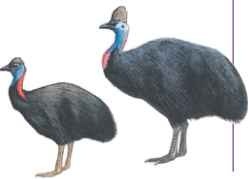
Double-wattled cassowary
| VITAL STATISTICS | |
| Weight | Male 64100 lbs.; female 127 lbs. |
| Length | 4-5.5′ |
| Sexual Maturity | 3 or 4 years |
| Breeding – Season Number 1 of Eggs |
June-October |
| 3-5 | |
| Incubation [ Period | About 50 days |
| Fledging :, Period | About 36 weeks |
| Breeding s Interval | Probably 1 year |
| Typical t Diet | Fallen fruit; fungi, insects, snails, small mammals and birds; carrion |
| Lifespan | At least 12-19 years |
RELATED SPECIES
• The Casuariiformes order has two families: the Dromaiidae (the Australian emu is the sole member) and Casuariidae, to which the double-wattled, northern (or single-wattled) and dwarf (or Bennett’s) cassowaries belong. Casuariiformes can’t fly, and walk or run on outsized legs — like their relatives the rheas of South America, kiwis of New Zealand and the ostrich of Africa.
